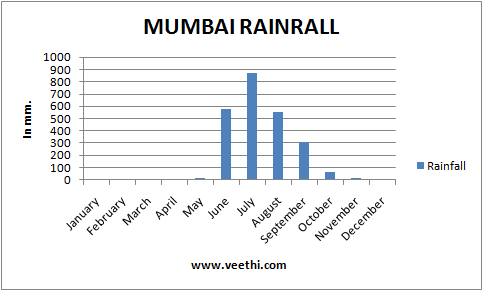The Devastating Flood that Leaves a Mark
By: Becca Alley, December 2012
In July 2005 Torrential rains created by India’s Monsoon season left over a thousand dead in the western coast and as little as one hundred people missing. Reports quoting government officials state that the flood was the worst they have seen in over a hundred years and disrupted the lives of about twenty million people and still counting. To first understand the scaring results of such an event we need to first look at what caused the hazard.
What is a Monsoon?
Monsoon season is a welcome relief to drought conditions in many areas of the world. For Mumbai they receive "80% of their annual rain fall in the months between June and September." Unfortunately monsoons, also known as rainy seasons, can also bring about widespread famine and enough rain to create massive floods that affect everything they touch. Monsoons are a shift in global wind patterns that cause excessive rainfall. During most of the year winds blow from land to ocean creating dry air, however during certain years these winds begin to blow from the ocean to land making the air moist, resulting in monstrous amounts of precipitation.
The Crisis Hits
On the afternoon of July 26th, 2005, a cloudburst suddenly overwhelmed the sky and instantly began dumping on the city filling it with endless gallons of water, submerging areas up to roof height. Streets became rivers, taking the area by surprise and shutting down the main transportation System. The nonfunctional electric train service, left thousands of commuters stranded. Cars broke down leading to terrible traffic jams along with disrupting electricity and the breakdown of telephone lines. Mumbai, being the commercial capital of India, came to a halt as the crisis hit in full force. The Floods also created problems with thousands of poor and homeless who live in one of the biggest slums of Asia. According to India’s Union Home Minister 942 people were killed by drowning electrocution, and landslides. 300 cases of cholera and other disease were reported along with 1200 buffalo, 15,000 sheep and goat dying in the flood. To make matters worse approximately 10,000 houses collapsed and 2254,000 of the crops were damaged.
Deaths: 1000
Affected: 20 Million
Missing: 100
Evacuated: 52,000 (in Maharashtra)
Financial Loss: US$ 1 Billion
Measures are being taken to prevent such a devastating flood from happening again in the Mumbai area. Researches spend hours puzzling over a problem that can only be solved with the governments and the nations help. This video explains one probable solution that is currently undergoing construction...

Why was it so Devastating?
Mumbai, a city with an enormous population of around 14 million people has seen unplanned construction of poor architecture in recent years. 70% of the people live in the slums, where there is little to no protection from such a disaster along with no accessibility to warning systems. Although the rain storm was reported the estimates were nowhere near the actual rain received by the civilization, marking 94 centimeters in a single day alone.
Although Mumbai is at a geographic risk for flooding the severity of the impact in the region had more to do with the lack of the government’s ability to carry out a disaster management plan along with adequate warning systems.
Poor mitigation was also a response to a lot of the damage and death toll. Water drainage systems being outdated would not run properly preventing mass amounts of water from filtrating back into the ocean.
As years go by Mumbai is taking new measures to prevent such destruction from reoccurring by first mitigation of the floods, and reducing vulnerability of extensive flooding in areas. Prediction and emergency preparedness (including monitoring and alerts) are being set up to sound in a moment’s notice. Post-flood, rescue and evacuation plans are being set up along with relief and rehabilitation efforts. It is also extremely important in minimizing flood hazards by education and creating awareness among the masses.

Effects of Mumbai Flooding
Primary
- Injury and loss of life
- Damage caused by water to famrs, homes, buildings, tracks, bridges roads.
Secondary
- River pollution
- Hunger disease
- Homelessness
Mumbai Climate in Monsoon Season
The monsoon season starts in June and ends in September. Monsoon season is marked by heavy thunderstorms and is almost windy. The rainfall is intense in July which is the wettest month. The climate ranges between 24 and 31 degree Celsius during this time. In July there is continuous nonstop rainfall and there is no sunshine for weeks. Some parts of the city are waterlogged during this time and this affects the public transport system to a great extent. Flooding is also not uncommon in certain areas. When the intensity of the monsoon rains becomes lesser in August the days are coolest and pleasant.

This graph shows the Mumbai's Monsoon season (June-September) and the average amount received in just those few months.

|
Natural disasters-work cited.docx Size : 13.771 Kb Type : docx |
(Attatched is a work cited page )

The graph above shows the population density located around the world. Population can have a direct correlation to the intensity of the damage that occurs by a hazard. The higher the population the more likely the natural hazard is to become an enormous disaster.